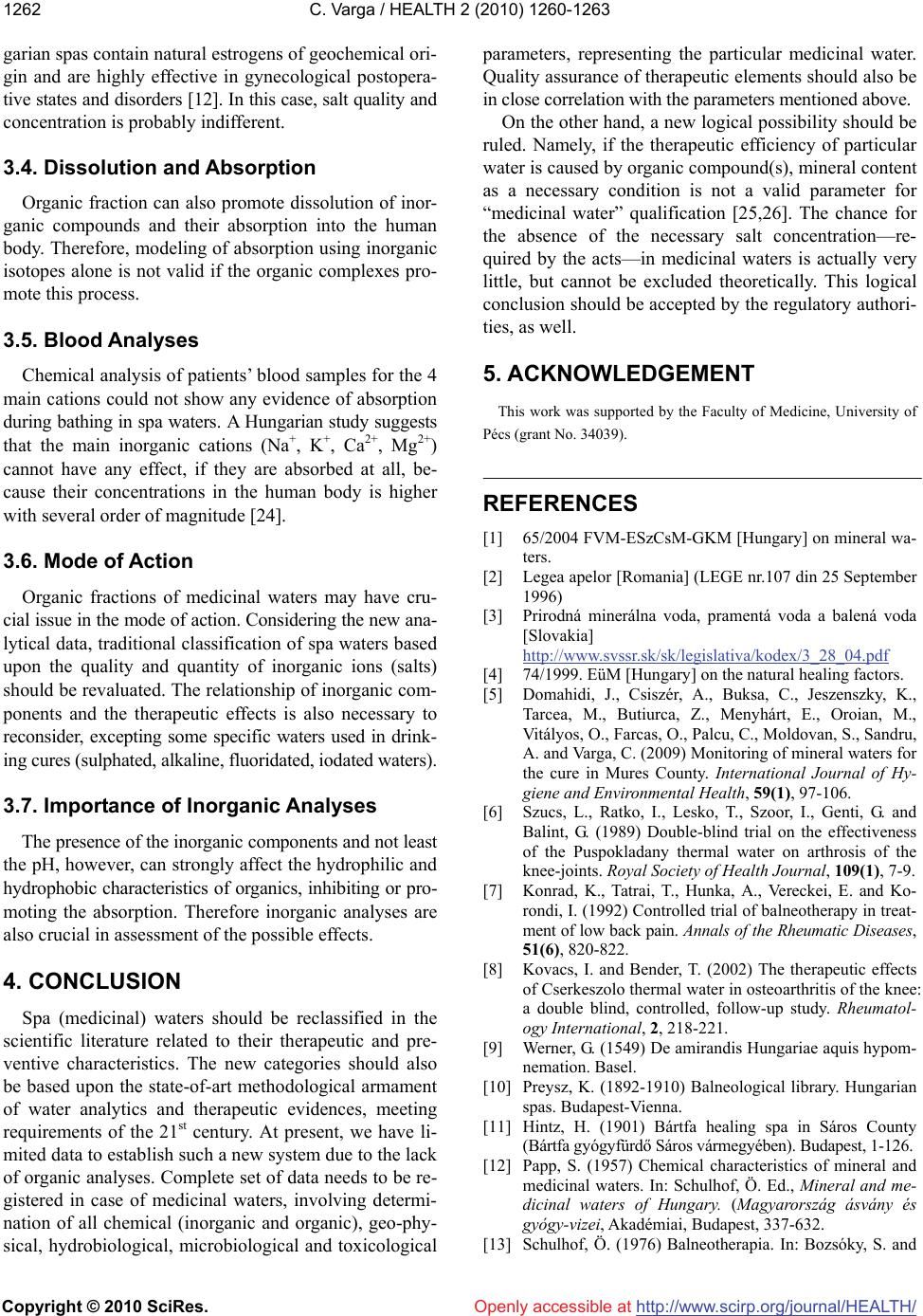
C. Varga / HEALTH 2 (2010) 1260-1263
Copyright © 2010 SciRes. http://www.scirp.org/journal/HEALTH/
1262
Openly accessible at
garian spas contain natural estrogens of geochemical ori-
gin and are highly effective in gynecological postopera-
tive states and disorders [12]. In this case, salt quality and
concentration is probably indifferent.
3.4. Dissolution and Absorption
Organic fraction can also promote dissolution of inor-
ganic compounds and their absorption into the human
body. Therefore, modeling of absorption using inorganic
isotopes alone is not valid if the organic complexes pro-
mote this process.
3.5. Blood Analyses
Chemical analysis of patients’ blood samples for the 4
main cations could not show any evidence of absorption
during bathing in spa waters. A Hungarian study suggests
that the main inorganic cations (Na+, K+, Ca2+, Mg2+)
cannot have any effect, if they are absorbed at all, be-
cause their concentrations in the human body is higher
with several order of magnitude [24].
3.6. Mode of Action
Organic fractions of medicinal waters may have cru-
cial issue in the mode of action. Considering the new ana-
lytical data, traditional classification of spa waters based
upon the quality and quantity of inorganic ions (salts)
should be revaluated. The relationship of inorganic com-
ponents and the therapeutic effects is also necessary to
reconsider, excepting some specific waters used in drink-
ing cures (sulphated, alkaline, fluoridated, iodated waters).
3.7. Importance of Inorganic Analyses
The presence of the inorganic components and not least
the pH, however, can strongly affect the hydrophilic and
hydrophobic characteristics of organics, inhibiting or pro-
moting the absorption. Therefore inorganic analyses are
also crucial in assessment of the possible effects.
4. CONCLUSION
Spa (medicinal) waters should be reclassified in the
scientific literature related to their therapeutic and pre-
ventive characteristics. The new categories should also
be based upon the state-of-art methodological armament
of water analytics and therapeutic evidences, meeting
requirements of the 21st century. At present, we have li-
mited data to establish such a new system due to the lack
of organic analyses. Complete set of data needs to be re-
gistered in case of medicinal waters, involving determi-
nation of all chemical (inorganic and organic), geo-phy-
sical, hydrobiological, microbiological and toxicological
parameters, representing the particular medicinal water.
Quality assurance of therapeutic elements should also be
in close correlation with the parameters mentioned above.
On the other hand, a new logical possibility should be
ruled. Namely, if the therapeutic efficiency of particular
water is caused by organic compound(s), mineral content
as a necessary condition is not a valid parameter for
“medicinal water” qualification [25,26]. The chance for
the absence of the necessary salt concentration—re-
quired by the acts—in medicinal waters is actually very
little, but cannot be excluded theoretically. This logical
conclusion should be accepted by the regulatory authori-
ties, as well.
5. ACKNOWLEDGEMENT
This work was supported by the Faculty of Medicine, University of
Pécs (grant No. 34039).
REFERENCES
[1] 65/2004 FVM-ESzCsM-GKM [Hungary] on mineral wa-
ters.
[2] Legea apelor [Romania] (LEGE nr.107 din 25 September
1996)
[3] Prirodná minerálna voda, pramentá voda a balená voda
[Slovakia]
http://www.svssr.sk/sk/legislativa/kodex/3_28_04.pdf
[4] 74/1999. EüM [Hungary] on the natural healing factors.
[5] Domahidi, J., Csiszér, A., Buksa, C., Jeszenszky, K.,
Tarcea, M., Butiurca, Z., Menyhárt, E., Oroian, M.,
Vitályos, O., Farcas, O., Palcu, C., Moldovan, S., Sandru,
A. and Varga, C. (2009) Monitoring of mineral waters for
the cure in Mures County. International Journal of Hy-
giene and Environmental Health, 59(1), 97-106.
[6] Szucs, L., Ratko, I., Lesko, T., Szoor, I., Genti, G. and
Balint, G. (1989) Double-blind trial on the effectiveness
of the Puspokladany thermal water on arthrosis of the
knee-joints. Royal Society of Health Journal, 109(1), 7-9.
[7] Konrad, K., Tatrai, T., Hunka, A., Vereckei, E. and Ko-
rondi, I. (1992) Controlled trial of balneotherapy in treat-
ment of low back pain. Annals of the Rheumatic Diseases,
51(6), 820-822.
[8] Kovacs, I. and Bender, T. (2002) The therapeutic effects
of Cserkeszolo thermal water in osteoarthritis of the knee:
a double blind, controlled, follow-up study. Rheumatol-
ogy International, 2, 218-221.
[9] Werner, G. (1549) De amirandis Hungariae aquis hypom-
nemation. Basel.
[10] Preysz, K. (1892-1910) Balneological library. Hungarian
spas. Budapest-Vienna.
[11] Hintz, H. (1901) Bártfa healing spa in Sáros County
(Bártfa gyógyfürdő Sáros vármegyében). Budapest, 1-126.
[12] Papp, S. (1957) Chemical characteristics of mineral and
medicinal waters. In: Schulhof, Ö. Ed., Mineral and me-
dicinal waters of Hungary. (Magyarország ásvány és
gyógy-vizei, Akadémiai, Budapest, 337-632.
[13] Schulhof, Ö. (1976) Balneotherapia. In: Bozsóky, S. and